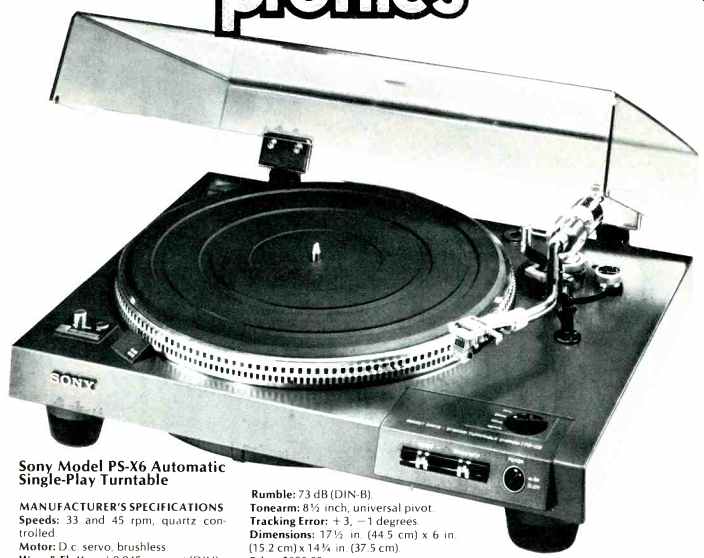
MANUFACTURER'S SPECIFICATIONS:
Speeds: 33 and 45 rpm, quartz controlled.
Motor: D.C. servo, brushless.
Wow & Flutter: ±0.045 per cent (DIN).
Rumble: 73 dB (DIN -B).
Tonearm: 8 1/2 inch, universal pivot.
Tracking Error: +3, -1 degrees.
Dimensions: 17 1/2 in. (44.5 cm) x 6 in. (15.2 cm) x 14 3/4 in. (37.5 cm).
Price: $290.00.
------------

Sony's new PS-X6 is an automatic, single-play turntable using a direct-drive motor that is servo locked to an extremely accurate quartz-crystal oscillator. Feedback signals are obtained from a sensor head which picks up pulses recorded on a ferro-magnetic strip bonded to the platter rim. A neon strobe light is located in a neat molding at the front on the left-hand side, but there is no variable speed control. Apparently, the strobe is there to reassure the user that the quartz lock is really working, which it certainly does. Incidentally, the neon is powered from the oscillator (120 Hz) and not from the a.c. line--an important point. The turntable speed pushbuttons are located on the left-hand side of the strobe light, and on the right-hand side is an angled subpanel on which are mounted a pair of touch-contact switches, consisting of tiny metal strips with LED indicators between them, for the Repeat and Start/Stop functions. The On/Oft switch is located next to them, and just behind it is the four-way rotary control ... the first three positions set the correct arm dropping points while the fourth switch sets the mechanism for manual operation.
An anti-skating dial is mounted on the circular arm base with the cue lever positioned in front of it. The tonearm itself is made of polished aluminum with a lateral balance weight on the left of the pivot and the conventional kind of rotatable counterweight at the rear. The headshell is the low-mass type with a four-pin termination ... now becoming the standard.
As mentioned earlier, the drive motor is servo controlled of the d.c. brushless type. The platter is made of diecast aluminum alloy and weighs nearly four pounds, including the extra thick rubber mat.
The styling is clean and uncluttered, and the unit comes complete with a nicely made hinged dustcover. The turntable base is made of SBMC (Sony Bulk Molding Compound) which has an attractive metallic finish. This material is claimed to be acoustically inert, and further isolation is provided by the four resilient feet which, by the way, can be leveled.

Measurements
For test purposes, a Stanton 881S phono cartridge was mounted in the headshell, and it was noted that a cardboard protractor was supplied to facilitate correct alignment. (Our sample came with a preliminary instruction manual.) Tracking error measured a fraction under 0.5 degrees per inch with very low vertical and lateral arm friction. Calibration of the tracking force dial was 10 percent light from 0.75 to 2.0 grams so I would recommend the use of a reliable external gauge if you intend to use a cartridge that requires a very low tracking force. The anti-skating dial was very accurate and, like the counterweight, it is calibrated from 0 to 3 grams. The tonearm resonance came out at 9.5 Hz with a rise of 5 dB, using the Stanton cartridge. Wow and flutter measured a low 0.05 per cent (DIN), and rumble was a very satisfactory -62 dB, using the ARLL rating.
For manual operation, the arm is moved to the required position and the Start/Stop switch is lightly touched, whereupon the arm is automatically towered while the platter starts turning. At the end of the record, the arm is automatically returned to its rest. position. The mechanism is triggered by a photocell sensor, so there is no force exerted on the cartridge stylus. The cue lift mechanism is well-damped and drift was negligible. In the completely automatic mode, the time taken before the stylus touched the record after touching the Start switch was just eight seconds. The turntable speed was "right on the nose" at both the 33 and 45 rpm settings, and it was not affected by powerline fluctuations.
Listening and Use Tests
The highly-resilient feet on the PS-X6 turntable definitely help to reduce acoustic feedback, plus the individual adjustment capabilities allow you to mount the turntable on uneven surfaces while insuring stability. I'm sure that many people will appreciate the convenience of having the operating controls exposed, even when the lid is shut, although the cue lever is not accessible. Quartz-lock controlled turntables are usually quite expensive and the Sony PS-X6 is a real bargain at $290.00. Sony's Model PS-X7 is identical except that it has a fluid -filled turntable mat and a carbon-fiber tonearm; these refinements raise the cost of the "7" by $55.00.
-George W. Tillett
(Audio magazine, July 1978)
Also see:
Sony PS-X800 Turntable (Dec. 1981)
Dual Model 1249 Automatic Turntable (Feb. 1977)
ADC Model LMF-2 Tonearm & ZLM Phono Cartridge (Jan. 1979)
= = = =